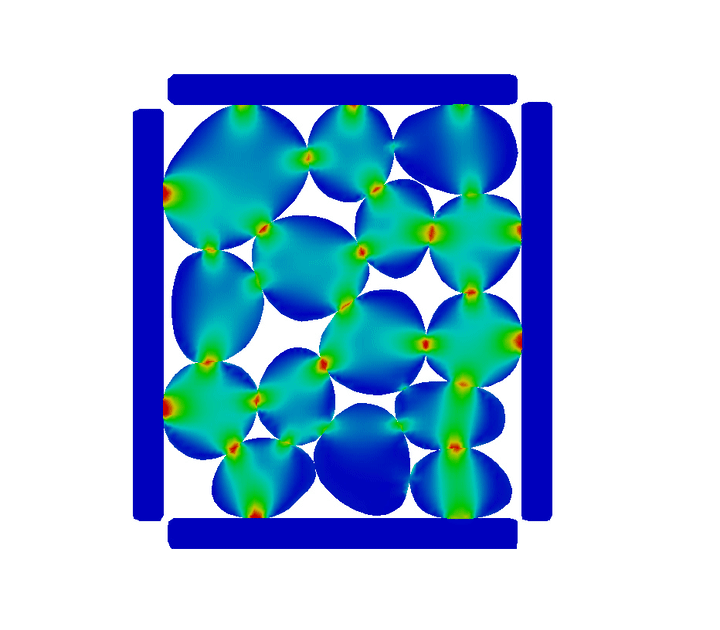|
We present a new thermal-mechanical-chemical-phase field model that captures the multi-physical coupling effects of precipitation creeping, crystal plasticity, anisotropic fracture, and crack healing in polycrystalline rock at various temperature and strain-rate regimes. This model is solved via a fast Fourier transfer solver with an operator-split algorithm to update displacement, temperature and phase field, and chemical concentration incrementally. In nuclear waste disposal in salt formation, brine inside the crystal salt may migrate along the grain boundary and cracks due to the gradient of interfacial energy and pressure. This migration has a significant implication on the permeability evolution, creep deformation, and crack healing within rock salt but is difficult to incorporate implicitly via effective medium theories compared with computational homogenization. As such, we introduce a thermodynamic framework and a corresponding computational implementation that explicitly captures the brine diffusion along the grain boundary and crack at the grain scale. Meanwhile, the anisotropic fracture and healing are captured via a high-order phase field that represents the regularized crack region in which a newly derived non-monotonic driving force is used to capture the fracture and healing due to the solution precipitation. Numerical examples are presented to demonstrate the capacity of the thermodynamic framework to capture the multiphysics material behaviors of rock salt. This paper is Part II of our work on modeling polycrystal salt for nuclear waste disposal. Reference
0 Comments
While crack nucleation and propagation in the brittle or quasi-brittle regime can be predicted via variational or material-force-based phase field fracture models, these models often assume that the underlying elastic response of the material is non-polar and yet a length scale parameter must be introduced to enable the sharp cracks represented by a regularized implicit function. However, many materials with internal microstructures that contain surface tension, micro-cracks, micro-fracture, inclusion, cavity or those of particulate nature often exhibit size-dependent behaviors in both the path-independent and path-dependent regimes. This paper is intended to introduce a unified treatment that captures the size effect of the materials in both elastic and damaged states. By introducing a cohesive micropolar phase field fracture theory, along with the computational model and validation exercises, we explore the interacting size-dependent elastic deformation and fracture mechanisms exhibits in materials of complex microstructures. To achieve this goal, we introduce the distinctive degradation functions of the force-stress-strain and couple-stress-micro-rotation energy-conjugated pairs for a given regularization profile such that the macroscopic size-dependent responses of the micropolar continua is insensitive to the length scale parameter of the regularized interface. Then, we apply the variational principle to derive governing equations from the micropolar stored energy and dissipative functionals. Numerical examples are introduced to demonstrate the proper way to identify material parameters and the capacity of the new formulation to simulate complex crack patterns in the quasi-static regime. [manuscript] One key drawback of classical discrete/distinct/granular element methods for particulate mechanics is that they cannot generate any kinetic and kinematics information at the sub-grain scales. Nevertheless, many dissipative mechanisms of granular materials are actually originated from path-dependent behaviors at the sub-grain scales where wear, damage, fracture and fragmentation occurs. This simplification therefore may lead to a departure of force chain topology and therefore make the resultant simulations inaccurate. Recovery of these sub-scale information while capturing the geometry and form of each individual grains is inherently a difficult task.
In this work, our postdoc Dr. Chuanqi Liu introduces an implicit material point method designed to bypass meshing of bodies by employing level set functions to represent boundaries at structured grids. This implicit function representation provides an elegant means to link an unbiased intermediate reference surface with the true boundaries by closest point projection as shown Leichner et al. 2019. We then enforce the contact constraints by a penalty method where the Coulomb friction law is implemented as an elastoplastic constitutive model such that a return mapping algorithm can be used to provide constitutive updates for both the stick and slip states. To evolve the geometry of the contacts properly, the Hamilton-Jacobi equation is solved incrementally such that the level set and material points are both updated according to the deformation field. To improve the accuracy and regularity of the numerical integration of the material point method, a moving least square method is used to project numerical values of the material points back to the standard locations for Gaussian-Legendre quadrature. Several benchmarks are used to verify the proposed model. Comparisons with discrete element simulations are made to analyze the importance of stress fields on predicting the macroscopic responses of granular assemblies. [manuscript] |
Group NewsNews about Computational Poromechanics lab at Columbia University. Categories
All
Archives
July 2023
|


 RSS Feed
RSS Feed